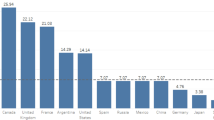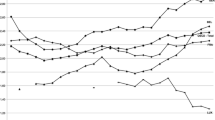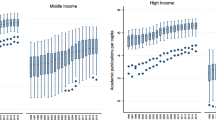Abstract
Due to recession in the world economy there is a trend towards a reduction in growth of R&D expenditure in the G7 countries. At the same time countries like China and Korea are investing more in scientific research. We compare the differences in the inputs to science for different countries and explore the level of efficiency in the output of scientific papers with respect to inputs such as manpower and investment. We find that the EU countries are relatively more efficient than Japan, the USA and also China and Korea so far as the production of papers is concerned. However, if efficiency is considered in terms of patents, Japan Korea and the USA are ahead. We compare our results with Albuquerque’s model linking patent to paper ratios and development, and find significant deviations for some countries. We deduce that there has been a shift from publishing towards patenting in certain countries and link it to high contribution from the business sector to R&D expenditure. Preliminary results of this analysis have been presented in Basu (In Proceedings of the 14th International Society for Scientometrics and Informetrics (ISSI) Conference, 2013).




Similar content being viewed by others
References
Adams, J., Pendlebury, D., & Stembridge, B. (2013). Building bricks, Thomson Reuters Report.
Albuquerque, E. (2005). Science and technology systems in less developed countries. In H. Moed, W. Glanzel, & U. Schmoch (Eds.), Handbook of quantitative science and technology research (pp. 759–778). Dordrecht: Kluwer Academic Publishers.
Basu, A. (2013). Efficiencies in national scientific productivity in terms of manpower and funding in science, In Proceedings of the 14th International Society for Scientometrics and Informetrics (ISSI) Conference (pp. 1954–1956), Vienna, July 15–19, 2013. http://www.issi2013.org/Images/ISSI_Proceedings_Volume_II.pdf. Accessed 3 Sept 2013.
Eurostat. (2012). Statistics explained, European Commission. http://epp.eurostat.ec.europa.eu/statistics_explained/index.php/R_%26_D_expenditure. Accessed 26 Feb 2012.
Foland, P., Shelton, R. D. (2010). Why is Europe so efficient at producing scientific papers, and does this explain the European Paradox? In 11th International Conference on S&T Indicators, Leiden, Sept. 10, 2010.
Hollanders, H., Soete, L. (2010). The growing role of knowledge in the global economy. In UNESCO Science Report 2010, UNESCO Publishing.
King, D. A. (2004). The scientific impact of nations. Nature, 430, 311–316.
Leydesdorff, L., & Wagner, C. (2009). Macro-level indicators of the relations between research funding and research output. Journal of Informetrics, 3(4), 353–362.
May, R. M. (1997). The scientific wealth of nations. Science, 7, 793–796.
OECD. (2011). Business R&D, In OECD science, technology and industry scoreboard 2011, OECD Publishing. doi:10.1787/sti_scoreboard-2011-18-en. Accessed 10 Jan 2012.
Rousseau, S., & Rousseau, R. (1998). The scientific wealth of European nations: Taking effectiveness into account. Scientometrics, 42(1), 75–87.
Shelton, R. D. (2008). Relations between national research investment and publication output: Application to an American Paradox. Scientometrics, 74(2), 191–205.
Shelton, R. D., & Leydesdorff, L. (2011). Publish or patent: Bibliometric evidence for empirical trade-offs in national funding strategies. Journal of the American Society for Information in Science and Technology, 63(3), 498–511.
UNESCO Science Report. (2010). Paris: UNESCO Publishing.
Vinkler, P. (2005). Science indicators, economic development and the wealth of nations. Scientometrics, 63, 417–419.
Vinkler, P. (2008). Correlation between the structure of scientific research, scientometric indicators and GDP in EU and non-EU countries. Scientometrics, 74(2), 237–254.
Wendt K., Aksnes D. W., Sivertsen, G., et al. (2012). Challenges in cross-national comparisons of R & D expenditure and publication output, In Proceedings of 17th International Conference on Science and Technology Indicators (Vol. 2, pp. 826–834).
Acknowledgments
The author thanks reviewers for their comments on an earlier draft of this paper. A grant from CSIR for support under the Emeritus Scientist scheme is gratefully acknowledged.
Author information
Authors and Affiliations
Corresponding author
Rights and permissions
About this article
Cite this article
Basu, A. The Albuquerque model and efficiency indicators in national scientific productivity with respect to manpower and funding in science. Scientometrics 100, 531–539 (2014). https://doi.org/10.1007/s11192-014-1254-2
Received:
Published:
Issue Date:
DOI: https://doi.org/10.1007/s11192-014-1254-2




